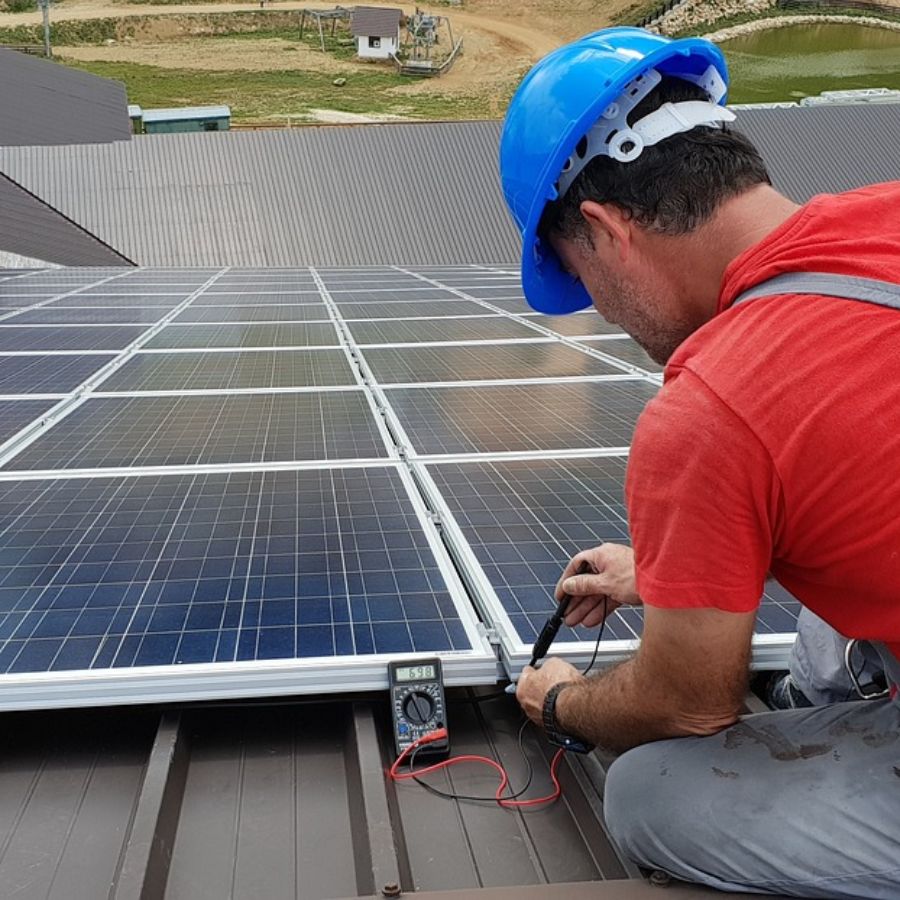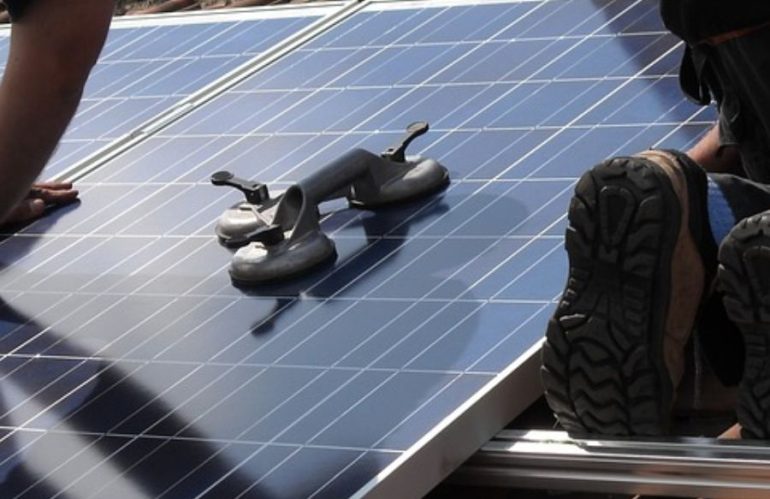With the increasing popularity of solar energy, many homeowners are considering installing solar panels on their roofs. Solar or photovoltaic (PV) panels harness sunlight to generate clean and renewable electricity. One crucial aspect of solar panel installation is understanding how to fix them to the roof securely. This article will explore the different mounting methods used to install solar panels.
Roof Attachments

Solar panels are typically attached to the roof using various mounting systems that ensure stability and durability. These attachments can prevent water leaks and maintain the roof’s integrity. Standard roof attachment methods include:
Roof Racking Systems
Roof Racking Systems are the most popular method for installing solar systems, streamlining the solar panel installation process. These systems utilize aluminum rails firmly attached to the roof using bolts or lag screws. The solar panels installed are then easily mounted onto these rails, allowing for simple adjustment and maintenance. The rails are commonly fixed to the roof’s rafters or structural supports, providing a reliable and durable mounting system to attach solar panels. Furthermore, they also ensure a secure installation.
Ballasted Systems
Ballasted systems are ideal for a flat roof when attaching solar panels. These systems leverage the weight of the solar panels and concrete blocks to secure them, ensuring stability without roof penetration. The panels are installed on a ballast tray or a weighted frame, providing a reliable mounting solution. This method is favored for its quick and non-invasive installation process, making it popular for those looking to harness solar power. Whether a flat roof or a tile roof, ballasted systems offer a convenient option for adding solar panels to your roof without compromising its integrity.
Roof Integrated Systems
Roof Integrated Systems offer a seamless integration of solar panels into the roof structure, making them an attractive option for homeowners. This installation method directly incorporates the solar system into the roof during construction or replacement. The panels blend seamlessly with the roof, providing a sleek and aesthetically pleasing appearance.
However, installing roof-integrated systems requires careful planning and collaboration between roofing and solar installation professionals. It is crucial to ensure proper integration and watertight sealing to maintain the roof’s integrity and prevent potential leaks. While ground-mounted systems may offer more flexibility in accessing direct sunlight, roof-integrated systems maximize the available roof space. One can efficiently use the area for solar panel installation.
Types of Roof Materials
The type of roof material plays a significant role in determining the installation method for solar panels. Different mounting techniques are employed to ensure compatibility and avoid damaging the roof. Here’s how solar panel fixing to specific roof materials happens:
Asphalt Shingles
Roof racking systems are the go-to choice when installing solar panels on asphalt shingle roofs. These systems involve attaching the mounting brackets to the rafters beneath the shingles, ensuring a secure and watertight installation.
One can securely anchor the solar panels by placing the mounting brackets directly on the roof’s structural supports. Flashing materials help seal around the brackets, effectively preventing water penetration. In addition, this ensures the roof remains protected while solar panels installation help to harness solar power. Asphalt shingle roofs are a common choice for homeowners. Using roof racking systems, they can easily integrate solar panels onto their roof, generating clean and renewable energy.
Metal Roofs
Metal roofs are highly durable and provide an ideal solar panel installation foundation. Regarding metal roof solar panel installation, racking systems are frequently helpful. These systems attach the mounting brackets to the metal seams or directly to the structural supports beneath. Moreover, it ensures a secure and stable foundation for the solar panel.
Specialized flashing creates a watertight seal around the mounting brackets, preventing water penetration. Again, that also helps to maintain the roof’s integrity. Metal roofs are an excellent choice for homeowners seeking to have solar panels installed. With racking systems and proper flashing techniques, metal roofs offer a reliable platform for harnessing solar energy.
Tile Roofs
When it comes to a tile roof, specialized mounting techniques help install a solar system. Mounting brackets can fit within the gaps between the tiles, ensuring a secure attachment. One must take care during installation to avoid any damage or cracking of the tiles. Flashing and sealants are applied around the brackets to maintain the roof’s integrity to create a watertight barrier. These protective measures prevent water from seeping through and causing leaks. Tile roofs are prevalent in certain regions due to their aesthetic appeal and durability.
Flat Roofs
Ballasted systems are popular when installing solar panels on a flat roof. These systems offer a non-penetrative solution, making them suitable for a flat roof. Solar panel installation uses strategically positioned concrete blocks or specialized ballast trays to provide adequate weight and keep the panels secure.
Rubber or plastic roof pads h to protect the roof’s membrane and ensure proper weight distribution. The weight of the concrete blocks or ballast trays, along with the added protection of roof pads, ensures the installed solar panels remain firmly in place. Besides, it does that without compromising the roof’s integrity. With ballasted systems, solar systems can be successfully installed on flat roofs, providing a reliable and efficient solution for harnessing solar energy.
Safety and Structural Considerations
When installing solar panels, safety, and structural considerations are paramount. It is essential to adhere to local building codes and regulations, ensuring the system is structurally sound and meets all safety requirements. Here are some key aspects to consider:
Load-Bearing Capacity
Assessing the load-bearing capacity of the roof is critical when installing solar systems. One must carefully evaluate the additional weight of the panels must be carefully evaluated to determine if any reinforcements are needed. Structural engineers play a vital role in this process, providing valuable insights and expertise. They consider various factors, including the design of the roof, the strength of the materials used, and the overall structural integrity.
By conducting thorough assessments, they can determine if the roof can support the added weight of the solar panels without compromising its stability. Structural engineers can recommend and implement reinforcements to ensure the roof can safely accommodate the solar panel system. By involving professionals in assessing load-bearing capacity, homeowners can have peace of mind knowing that their solar panels’ installation happens on a structurally sound and secure roof.
Wind Resistance
Proper mounting and anchoring methods ensure the solar panels can withstand high winds and severe weather conditions. Wind uplift calculations help to determine the necessary precautions. Reinforcements, such as additional roof attachments, bracing systems, or hurricane clips, may be required, depending on the area’s wind load requirements.
Electrical Safety
It is important to consider electrical safety during installation. Proper grounding and adherence to electrical codes are essential to prevent electrical hazards and ensure a safe system. Qualified electricians should handle the electrical connections and ensure the system is wired correctly, grounded, and equipped with appropriate safety mechanisms.
Conclusion
Solar panels are an excellent investment for homeowners seeking clean, renewable energy solutions. Understanding how solar panels fixing to the roof happens is crucial for a successful installation. Roof attachments such as racking, ballasted, and roof-integrated systems are used depending on the roof type. Safety and structural considerations are vital, and following local building codes and regulations is crucial. Homeowners can confidently make informed decisions and embark on their solar journey by consulting reputable government and educational sources.

